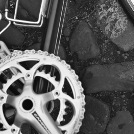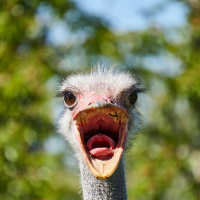Giro 2022 - Stage 16: Salò – Aprica 202 km ***Spoilers***

Tuesday, May 24th, 10:00 BST
Straight after the final rest day, comes the queen stage. Across the Alps, with over 5,000 m vertical altitude gain, over four intermediate climbs to a downhill finish in Aprica. The last time the Giro finished in Aprica was seven years ago, when Mikel Landa won the stage ahead of Steven Kruijswijk and Alberto Contador.
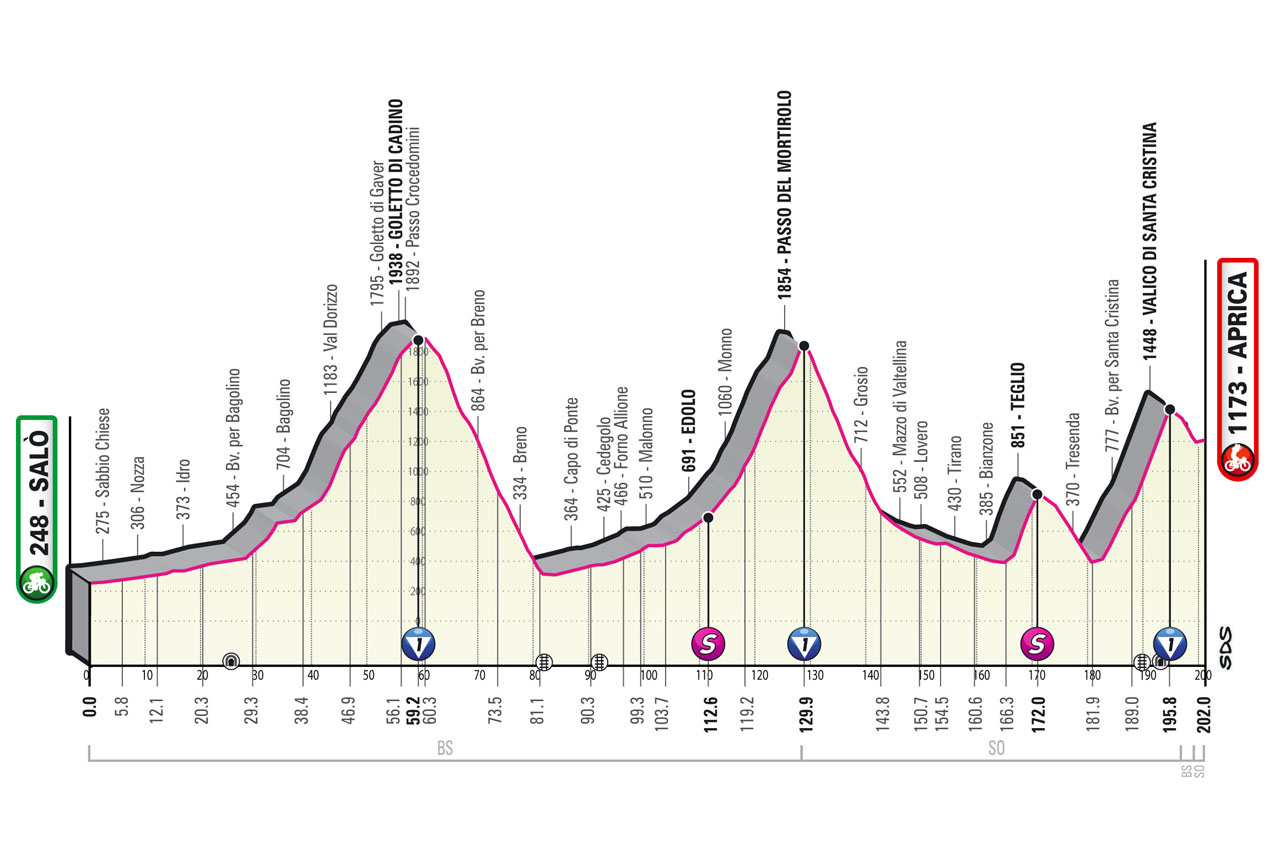
The race kicks into gear in Salò on Lake Garda and enters the first climb after 30kms, Goletto di Cadino, better known as Passo Crocedomini shortly leaving the shores of Lake Idro. At the bottom, the route will keep heading north along the Valcamonica for a little over 30 kms. After reaching the town of Edolo, the second climb of the day, the mythical Passo del Mortirolo (GPM1, 12.6 km at 7.6%) starts, albeit from the easier ascent. After descending to Mazzo and a section in the valley of the Adda river the short climb to Teglio appears. Then back into the valley to tackle the Passo di Santa Cristina. This is a climb on a very narrow road with the gradients constantly hovering around 10% in the last 5 kilometres.
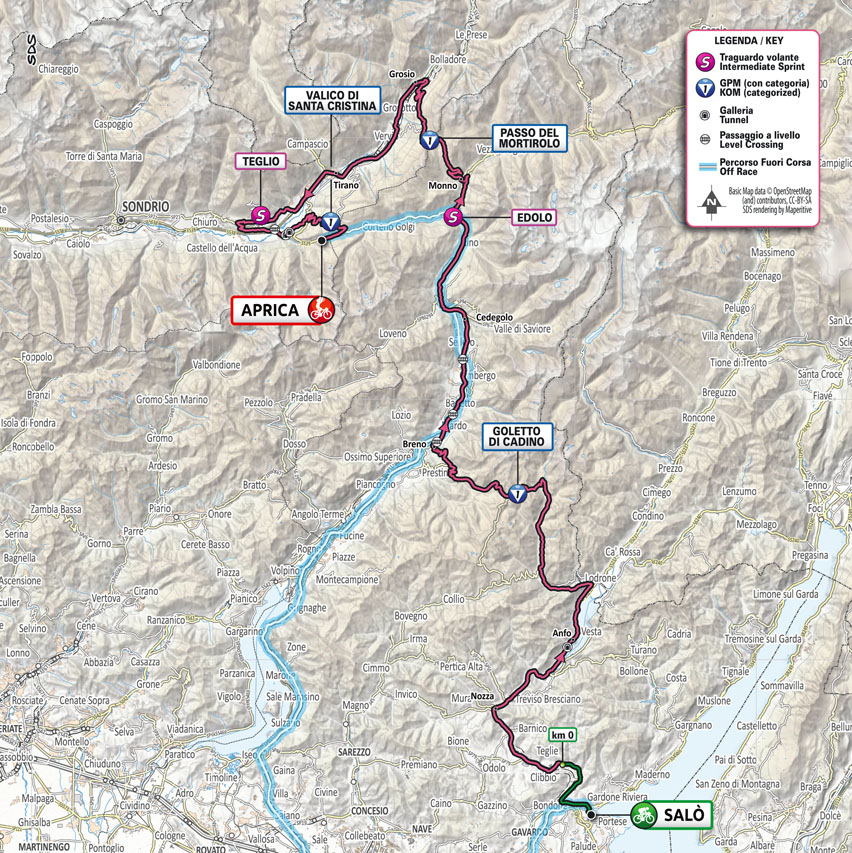
The Climbs:
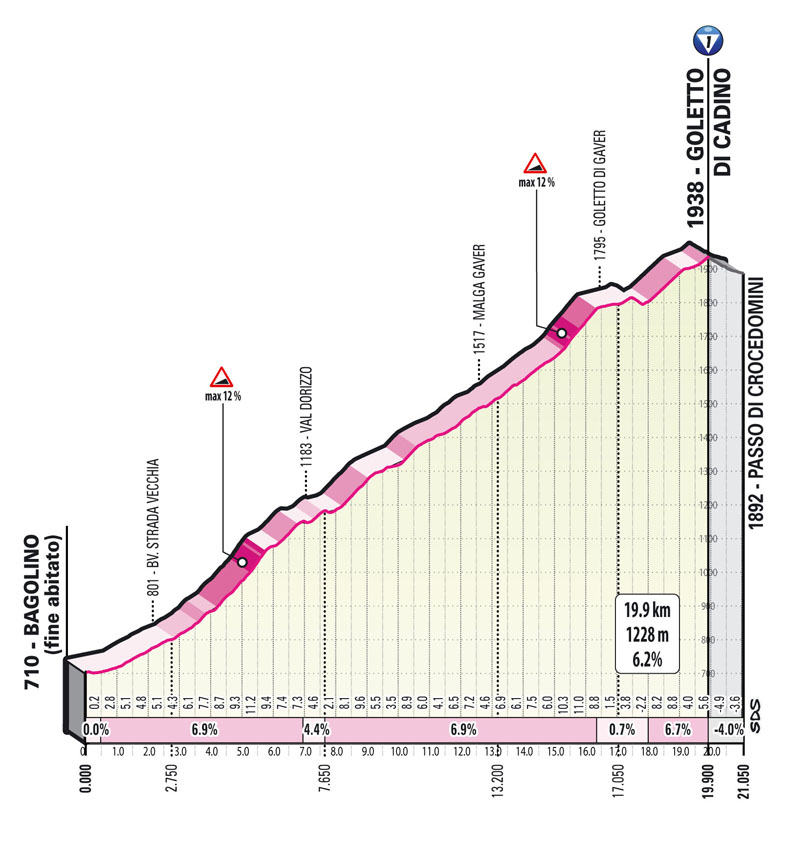
Legend has it that the pass was named after a fierce battle that took place there in AD 773, when Charlemagne crossed swords with the Lombard military, which had been defeated in the battle of Pavia. The Carolingian army chased and found them by the pass, killing hundreds of enemy troops. The mountain was hence named Mortarolo (after ‘morte’, meaning ‘death’) and, centuries later, Mortirolo.
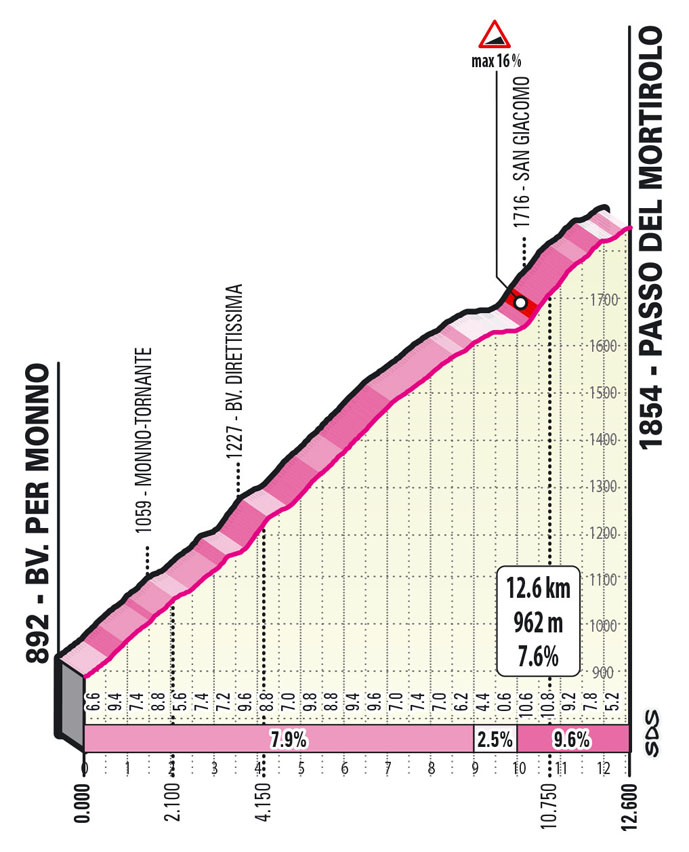
The climb passed into cycling legend on June 3, 1990.
The ascent was from Edolo, and Venezuela’s Leonardo Sierra, first to the summit, eventually took the stage.
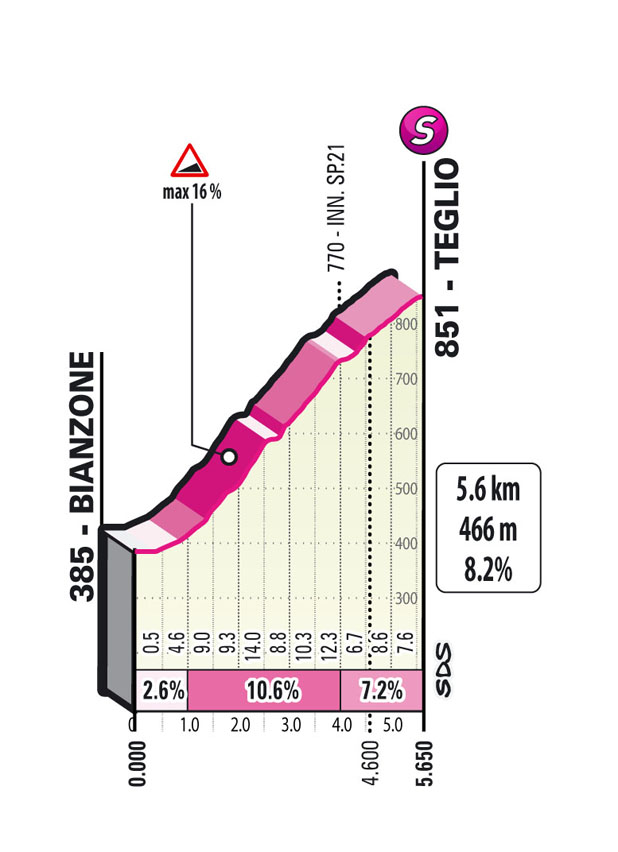
Then came 1994, the year when both the Mortirolo and Marco Pantani – two matching, twin stories –ultimately became legends.
June 5 was the day of the Merano-Aprica stage, with the Stelvio, Mortirolo and Santa Cristina climbs scheduled in order.
The Pirate, who was only 24 at that time, attacked along the punishing slopes of the second climb, at over 60 kilometres out.
He dropped Indurain, Bugno, Chiappucci and the Maglia Rosa Berzin, soloing over the top. He waited for Indurain in the flat stretch before the final ascent, where he took off again – this time for good – dashing to the line to take stage victory and the second place on GC. In 2006, a sculpture was placed at the 8th kilometre of the Mortirolo to commemorate that accomplishment.

The Passo (or Valico) di Santa Cristina also featured in that stage, the Merano-Aprica stage of 1994.
On that day, this iconic climb first featured in the route of the Giro d’Italia and a virtually unknown Marco Pantani took centre stage for the first time.
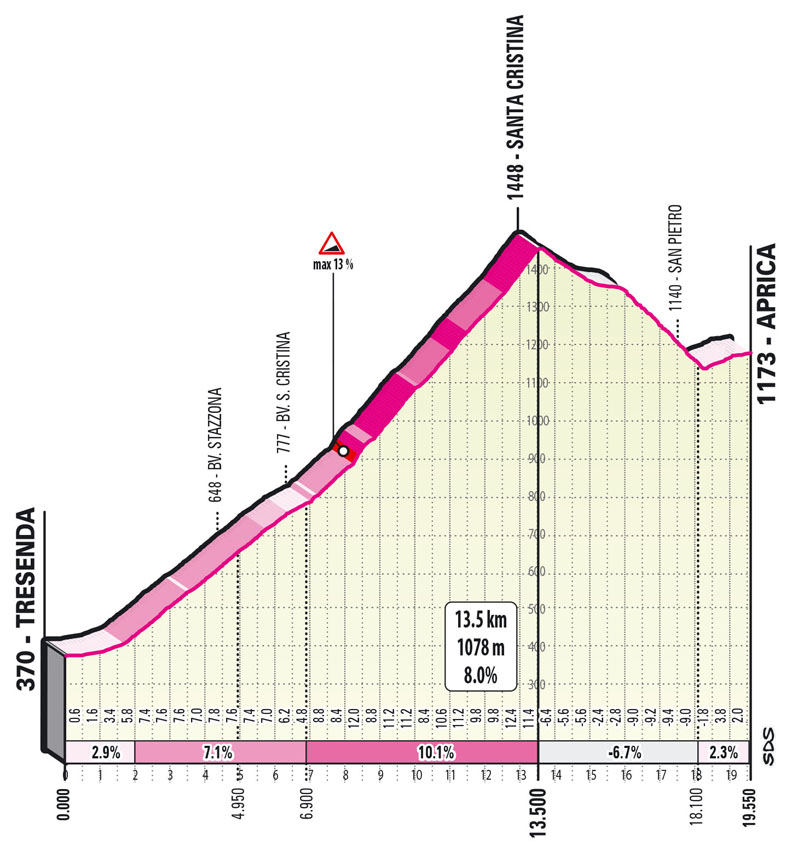
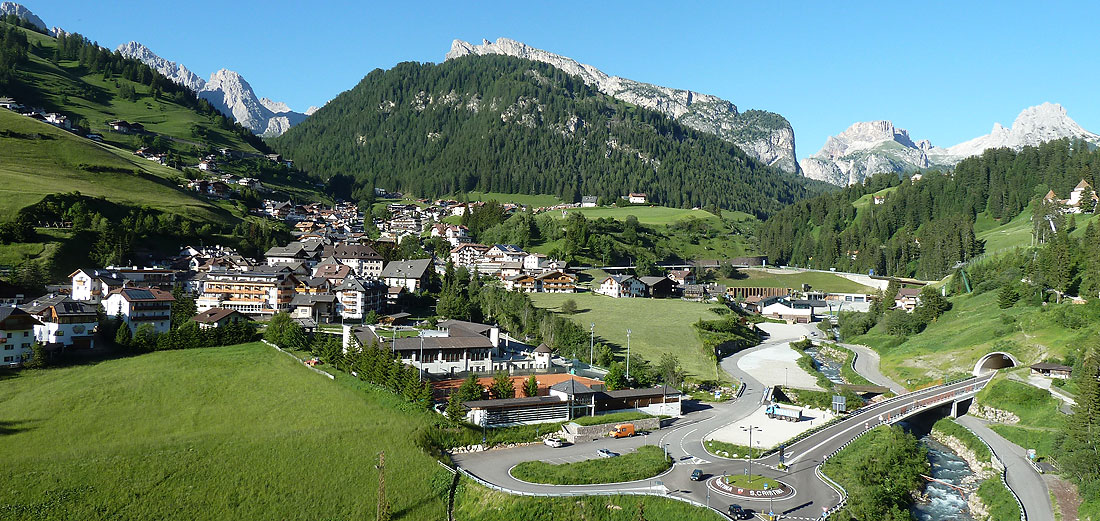
Final Kms.
The descent from the Valico di Santa Cristina to the ‑1,500 m marker is highly technical, on narrow road and with sharp gradients. In the closing stretch, the route rises steadily at around 3% all the way to the finish (on tarmac). The run-in to Aprica is relatively easy.
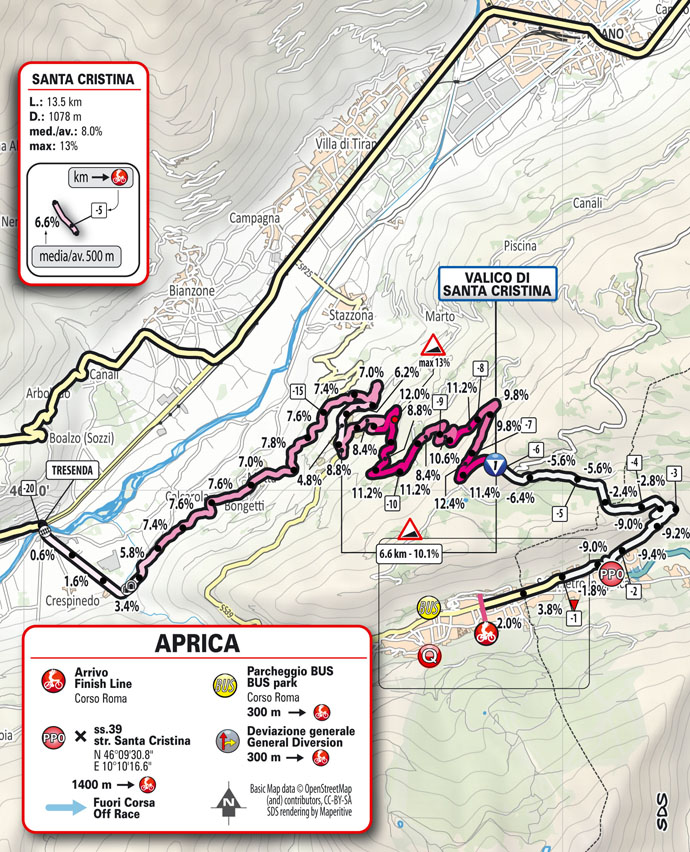

What to expect:
A hard fight to get into a large breakaway. Probably Ineos to do the lion's share of the graft in the peloton, while the multi-cols work the wearing down process.
Very unlikely that the GC battle will commence before the final climb. Very likely someone will come a cropper on the final descent.
Favourites 16th stage 2022 Giro d’Italia
***** Richard Carapaz, Jai Hindley
**** Mikel Landa, Simon Yates
*** João Almeida, Pello Bilbao, Domenico Pozzovivo
** Giulio Ciccone, Vincenzo Nibali, Emmanuel Buchmann
* Wilco Kelderman, Hugh Carthy, Alejandro Valverde
Salò
Salò is a town and comune in the Province of Brescia in the region of Lombardy on the banks of Lake Garda, on which it has the longest promenade.
Salò has always played a crucial role in the history of Lake Garda and Italy. The traditional Gasparo da Salò international violin festival, now in 64th edition seen among the longest-lasting and most famous summer festivals in Italy.

The stage is also dubbed the Sforzato Wine stage.
Sforzato di Valtellina wine produced on the steep slopes in Sondrio, Lombardy, with a minimum of 90% Nebbiolo grapes, locally known as Chiavennasca. The wines are produced in a passito process—drying or raisinating the grapes before vinification—which concentrates sugars and acidity.
The resulting wines are full-bodied, intense, and concentrated, with slightly higher alcohol content. They are aged for at least 20 months, with at least 12 in a barrel. These powerful wines usually display a complex aroma reminiscent of sweet spices, ripe fruit, and fruit jam, along with hints of balsamic notes, tobacco, and coffee.
Sforzato is a wine with a bold and rich character that can be enjoyed on its own. It would also pair with red meat, game, and local specialties. Interestingly, Sforzato was the first raisin wine in Italy with a DOCG status.
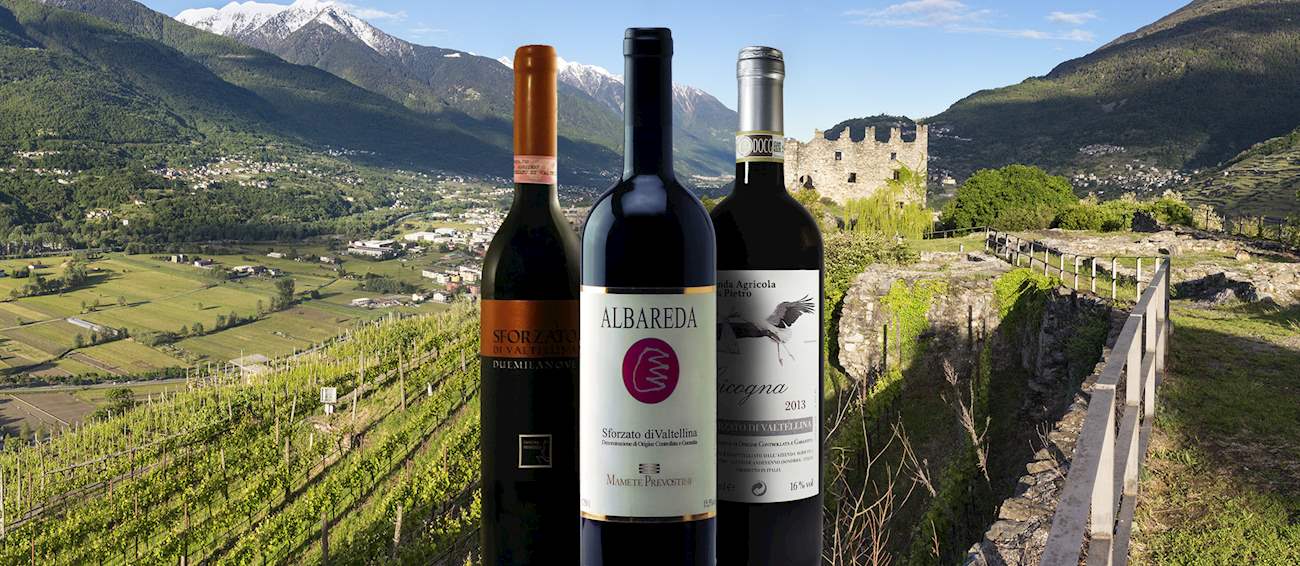
Other typical products of the western shore of Lake Garda are capers, traditionally conserved in olive oil or salt; the Garda truffle; cheese, from the Tremosine cheese to the Tombea cheese; honey, nutritious and of excellent quality, and grappa, produced in particular in the Tignale area.

Aprica
Aprica links Valtellina with Valcamonica in the heart of italian Alps. Aprica will be familiar to many road riders as it often features in game-changing stages of the Giro d’Italia. Hit it up for some rewarding climbs, including the iconic Mortirolo and Santa Cristina. Aprica is an all year round resort, with biking in the Summer and skiing in the Winter, including super panoramic Baradello run, which is now the longest floodlit pist in Europe.

Valtellina and Aprica are famous for their food excellence. Many of its products are certified as PDO and PGI certified. The local cheeses, wines, bresaola, apples and pizzoccheri are the outcome of this territory. Valtellina is also known worldwide for its pizzoccheri. It’s a first course that encloses the authentic taste of Valtellina. Fresh buckwheat pasta, potatoes, cabbage, cheese, and Malga butter are the main ingredients.
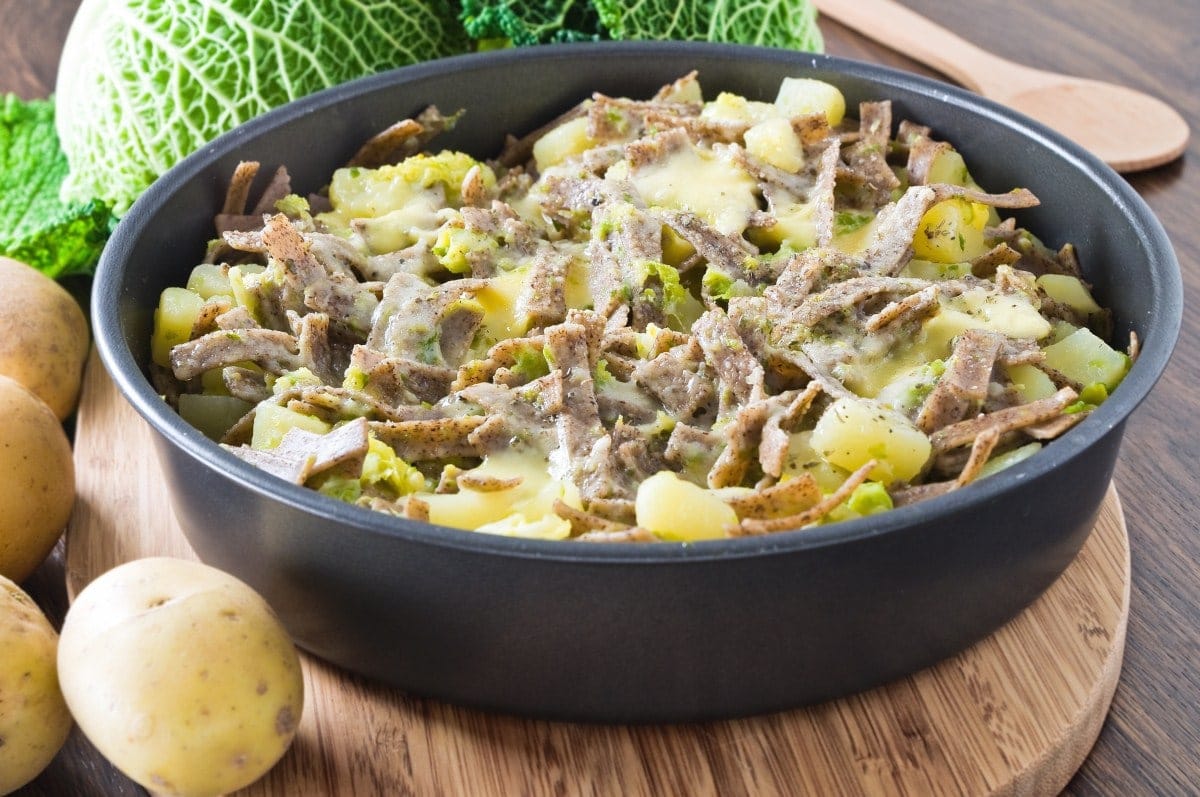
Aprica’s traditional dessert is called panvì, which consists of slices of rye bread toasted in butter and sprinkled with red wine and sugar.

Comments
-
Ouch - a day when there can be 3km at 10.6% in the middle of a climb and it's not classified.0
-
That's going to be a painful day!
Still they get to start in a stunning location on Lake Garda!0 -
Would I be correct in saying that is the "easy" way up the Mortirolo with the harder classic climb being from Mazzo di Valtellina?
The above may be fact, or fiction, I may be serious, I may be jesting.
I am not sure. You have no chance.Veronese68 wrote:PB is the most sensible person on here.0 -
That's right - the hard side is 11km at 11%. Ish.pblakeney said:Would I be correct in saying that is the "easy" way up the Mortirolo with the harder classic climb being from Mazzo di Valtellina?
Never done it, not sure I fancy it.0 -
That's what I figured. I should have said feared as I'm doing it from Mazzo di Valtellina in 8-1/2 weeks. I do know that it is bloody hard doing it virtually.kingstongraham said:
That's right - the hard side is 11km at 11%. Ish.pblakeney said:Would I be correct in saying that is the "easy" way up the Mortirolo with the harder classic climb being from Mazzo di Valtellina?
Never done it, not sure I fancy it.The above may be fact, or fiction, I may be serious, I may be jesting.
I am not sure. You have no chance.Veronese68 wrote:PB is the most sensible person on here.0 -
If you're going to do it, that's surely the only side worth doing. Good luck!pblakeney said:
That's what I figured. I should have said feared as I'm doing it from Mazzo di Valtellina in 8-1/2 weeks. I do know that it is bloody hard doing it virtually.kingstongraham said:
That's right - the hard side is 11km at 11%. Ish.pblakeney said:Would I be correct in saying that is the "easy" way up the Mortirolo with the harder classic climb being from Mazzo di Valtellina?
Never done it, not sure I fancy it.0 -
Fair point, well made.kingstongraham said:
If you're going to do it, that's surely the only side worth doing. Good luck!pblakeney said:
That's what I figured. I should have said feared as I'm doing it from Mazzo di Valtellina in 8-1/2 weeks. I do know that it is bloody hard doing it virtually.kingstongraham said:
That's right - the hard side is 11km at 11%. Ish.pblakeney said:Would I be correct in saying that is the "easy" way up the Mortirolo with the harder classic climb being from Mazzo di Valtellina?
Never done it, not sure I fancy it.
Makes the stage slightly less interesting from a personal point of view.
Saturday's should make up for a bit as they are also doing the Fedaia in the opposite direction to me. Will watch the Pordoi with keen interest.The above may be fact, or fiction, I may be serious, I may be jesting.
I am not sure. You have no chance.Veronese68 wrote:PB is the most sensible person on here.0 -
If you are doing the Mortirolo from Mazzo, then I strongly recommend you don't do the Gavia first. 😁
The hardest aspect, for me at least, was the heat. You're pretty low down for a lot of the Mortirolo and if it's hot in the valley then it never really cools down much as you climb.0 -
Stelvio and the Gavia are the day before. 🤪
Just to pass the time on the rest day for anyone even slightly interested....
Although with all the criss crossing I may have a couple of directions mixed up as I now think I'll be doing the Fedaia in the same direction as the Giro. 🤔
Dolomites
Day 01 - Pre tour warm up (Anti-clockwise direction) 62km, 2096m
Passo Falzarego from Cortina
Passo Giau
Day 02 - Pre tour warm up (Clockwise direction) 62km, 2096m
Passo Giau from Cortina
Passo Falzarego
Day 1 - 87km, 2310m
Passo di Cimabanche to Carbonin Schluderbach
Rifugio Aronzo/Tre Cime (from Misurina out & back)
Passo Tre Croci (From Misurina)
Passo Falzarego
Day 2 - 92km, 3050m
Passo Giau
Passo Fedaia to Canazei
Passo Pordoi to Canazei
Passo di Campolongo from Arabba
Day 3 - Maratona - 138km, 4230m
Passo di Campolongo 1st to Arabba
Passo Pordoi
Passo di Sella from Canazei
Passo di Gardena
Passo di Campolongo 2nd
Passo Giau (From West, Posalz)
Passo di Valparola (from Pocol)
Day 4 - 79km, 2550m
Stelvio - Passo Dello Stelvio From Prato
Torri di Fraele (From Bormio)
Day 5 - 104km, 3050m
Stelvio - Passo Dello Stelvio From Bormio
Gavia - Passo di Gavia
Day 6 - 129km, 3500m
Foscagno Pass (To Livigno)
Passo dell’Eira (From Livigno)
MortiroloThe above may be fact, or fiction, I may be serious, I may be jesting.
I am not sure. You have no chance.Veronese68 wrote:PB is the most sensible person on here.1 -
Fedaia the way they are doing it is the hardest climb I've ever done. The 3km straight at 12% is etched in my memory. The other side is a piece of cake!pblakeney said:
Fair point, well made.kingstongraham said:
If you're going to do it, that's surely the only side worth doing. Good luck!pblakeney said:
That's what I figured. I should have said feared as I'm doing it from Mazzo di Valtellina in 8-1/2 weeks. I do know that it is bloody hard doing it virtually.kingstongraham said:
That's right - the hard side is 11km at 11%. Ish.pblakeney said:Would I be correct in saying that is the "easy" way up the Mortirolo with the harder classic climb being from Mazzo di Valtellina?
Never done it, not sure I fancy it.
Makes the stage slightly less interesting from a personal point of view.
Saturday's should make up for a bit as they are also doing the Fedaia in the opposite direction to me. Will watch the Pordoi with keen interest.
It's all ridiculously gorgeous though.1 -
Col Collective have that side on You Tube. Starts at 10% I think.pblakeney said:
That's what I figured. I should have said feared as I'm doing it from Mazzo di Valtellina in 8-1/2 weeks. I do know that it is bloody hard doing it virtually.kingstongraham said:
That's right - the hard side is 11km at 11%. Ish.pblakeney said:Would I be correct in saying that is the "easy" way up the Mortirolo with the harder classic climb being from Mazzo di Valtellina?
Never done it, not sure I fancy it. https://www.youtube.com/watch?v=V3F0HlRnIqE 0
https://www.youtube.com/watch?v=V3F0HlRnIqE 0 -
If you're doing Giau then Fedaia then Pordoi, then congratulations, you're going up the hard side.0
-
Yup. That's the one. I think there will be quite a few spells out of the saddle even on a compact 34 with a specially bought 32 cassette.The above may be fact, or fiction, I may be serious, I may be jesting.
I am not sure. You have no chance.Veronese68 wrote:PB is the most sensible person on here.0 -
I have some pride.ddraver said:GRX FTW!

And willing to suffer for it. 😉The above may be fact, or fiction, I may be serious, I may be jesting.
I am not sure. You have no chance.Veronese68 wrote:PB is the most sensible person on here.0 -
Oh well....
A strong disturbance will reach Italy on Tuesday with intense thunderstorms forecast for the northern regions.
"Science is a tool for cheaters". An anonymous French PE teacher.0 -
It's a horrible climb. Did it after doing the Gavia and it's unrelenting. It's interesting given its stature in the sport that it has never been a summit finish. They always head down and finish in Aprica. That said, whenever it has been included it has always busted up the lead group such that the ascent to Aprica is contested by a handful of leaders at most.kingstongraham said:
That's right - the hard side is 11km at 11%. Ish.pblakeney said:Would I be correct in saying that is the "easy" way up the Mortirolo with the harder classic climb being from Mazzo di Valtellina?
Never done it, not sure I fancy it.0 -
I believe the Sottoguda is still shut after bad flood damage a few years ago, which is a shame, as that's a stunning part of the climb. That straight section up to Capanna Bill though. Ouch.kingstongraham said:
Fedaia the way they are doing it is the hardest climb I've ever done. The 3km straight at 12% is etched in my memory. The other side is a piece of cake!pblakeney said:
Fair point, well made.kingstongraham said:
If you're going to do it, that's surely the only side worth doing. Good luck!pblakeney said:
That's what I figured. I should have said feared as I'm doing it from Mazzo di Valtellina in 8-1/2 weeks. I do know that it is bloody hard doing it virtually.kingstongraham said:
That's right - the hard side is 11km at 11%. Ish.pblakeney said:Would I be correct in saying that is the "easy" way up the Mortirolo with the harder classic climb being from Mazzo di Valtellina?
Never done it, not sure I fancy it.
Makes the stage slightly less interesting from a personal point of view.
Saturday's should make up for a bit as they are also doing the Fedaia in the opposite direction to me. Will watch the Pordoi with keen interest.
It's all ridiculously gorgeous though.0 -
0.5mm doesn't sound like much.blazing_saddles said:Oh well....
A strong disturbance will reach Italy on Tuesday with intense thunderstorms forecast for the northern regions.
Guess it's different if localised.The above may be fact, or fiction, I may be serious, I may be jesting.
I am not sure. You have no chance.Veronese68 wrote:PB is the most sensible person on here.0 -
Aprica = Pantani
left the forum March 20230 -
A nice legend, and I've no idea how true, although I can't imagine any army wanting to climb up to nearly 2000 m when it's not that far to just stay in the valleys and go around the mountain.blazing_saddles said:
Legend has it that the pass was named after a fierce battle that took place there in AD 773, when Charlemagne crossed swords with the Lombard military, which had been defeated in the battle of Pavia. The Carolingian army chased and found them by the pass, killing hundreds of enemy troops. The mountain was hence named Mortarolo (after ‘morte’, meaning ‘death’) and, centuries later, Mortirolo.
The Giro will actually ride over the Passo dell Foppa, although one can understand why it's now referred to as Mortirolo; I think no one with any French can mistake the implication.
The top of the real Passo del Mortirolo is about 550 m NE from the top of the Foppa. It is a rough track which, coming from Monno, starts near the Albergo Passo Mortirolo (at about elevation 1840 m), rises to about 1895 m (where there are a couple of old farmhouses), then drops to meet asphalted road to Grosio again after the turnoff to Mazza di Valtellina and where there are a few buildings alongside the road (at about elevation 1550 m).0 -
Yes, as KG pointed out, and you've since edited your post about, you are riding the harder side of the Fedaia and not (as you first seemed to think) the opposite way to the Giro.pblakeney said:
Just to pass the time on the rest day for anyone even slightly interested....
Although with all the criss crossing I may have a couple of directions mixed up as I now think I'll be doing the Fedaia in the same direction as the Giro. 🤔
So you've a challenge ahead, although I think it a pity you aren't also riding the Fedaia from the west too, like you'll do the Giau from both sides - not everything has to be a challenge. I loved descending the Fedaia and even more the Giau from the west - speed merchant!
Although I wonder why you (or your trip organisers have made it so) are riding up the Falzarego 3 times (days 01, 1, and 3, the last on the way to Valparola) - I found the Falzarego climb from Cortina a real drag, not what I'd tag on at the end of a hard day just to get more kms in, which is what it certainly appears to be for you on day 1.
But I like that you are riding the Sella Ronda clockwise – I think clockwise far the preferable direction to ride it scenerywise (I've ridden it twice clockwise, once anti), and I don't understand why the Sella-Ronda organisers recommend anti-clockwise for the one or two days each year when the route is prohibited to cars/motorbikes and just open to bicycles.
Enjoy the Stelvio! I've found it pretty straightforward (now 3 times) despite its visually imposing serpentines, albeit the 5 km after Trafoi can feel hard, before from Prato having been easy, but then you come out of the trees and see the vista and become inspired.
0 -
I have ...avoid unless your in your high fitness modekingstongraham said:
That's right - the hard side is 11km at 11%. Ish.pblakeney said:Would I be correct in saying that is the "easy" way up the Mortirolo with the harder classic climb being from Mazzo di Valtellina?
Never done it, not sure I fancy it."If I was a 38 year old man, I definitely wouldn't be riding a bright yellow bike with Hello Kitty disc wheels, put it that way. What we're witnessing here is the world's most high profile mid-life crisis" Afx237vi Mon Jul 20, 2009 2:43 pm0 -
What a monster of a stage"If I was a 38 year old man, I definitely wouldn't be riding a bright yellow bike with Hello Kitty disc wheels, put it that way. What we're witnessing here is the world's most high profile mid-life crisis" Afx237vi Mon Jul 20, 2009 2:43 pm0
-
Days 01 & 02 are because I arrive 2 days early as there is no direct flights on the day.jimmyjams said:
Although I wonder why you (or your trip organisers have made it so) are riding up the Falzarego 3 times (days 01, 1, and 3, the last on the way to Valparola) ...
Option 1 - Early start, transfer, late arrival. Done before, not preferred.
Option 2 - Fly day before with hotel stay at transfer. More practical but meh.
Option 3 - Fly direct 2 days before and have the hotel stay at location. 😃😎🚴
The hotel is at Pocol so my plan is breakfast, drop down to Cortina for coffee and do the climbs proper in both directions but slowly from there with a lunch stop 1/2 way and stopping for photos.
Marmot have you do the Falzarego from Cortina then drop back to the hotel on day1.
Then it is done from the other side to Valparola on day 3 as part of the Maratona route.
That's the challenge route, there are easier options if the legs dictate.
Your other comments are much appreciated.
Been a good rest day this... 😉The above may be fact, or fiction, I may be serious, I may be jesting.
I am not sure. You have no chance.Veronese68 wrote:PB is the most sensible person on here.0 -
What a monster of a stage
It better not effect the raceblazing_saddles said:Oh well....
A strong disturbance will reach Italy on Tuesday with intense thunderstorms forecast for the northern regions. "If I was a 38 year old man, I definitely wouldn't be riding a bright yellow bike with Hello Kitty disc wheels, put it that way. What we're witnessing here is the world's most high profile mid-life crisis" Afx237vi Mon Jul 20, 2009 2:43 pm0
"If I was a 38 year old man, I definitely wouldn't be riding a bright yellow bike with Hello Kitty disc wheels, put it that way. What we're witnessing here is the world's most high profile mid-life crisis" Afx237vi Mon Jul 20, 2009 2:43 pm0 -
If you're in Pocol rather than do the Falzarego a few times, why not pop down to Cortina and ride over the Tre Croci and on up to Tre Cime? The Croci is a nice warm up climb and you go past Misurina, which is lovely, before the tough climb up to Cime and the incredible views at the top.pblakeney said:
Days 01 & 02 are because I arrive 2 days early as there is no direct flights on the day.jimmyjams said:
Although I wonder why you (or your trip organisers have made it so) are riding up the Falzarego 3 times (days 01, 1, and 3, the last on the way to Valparola) ...
Option 1 - Early start, transfer, late arrival. Done before, not preferred.
Option 2 - Fly day before with hotel stay at transfer. More practical but meh.
Option 3 - Fly direct 2 days before and have the hotel stay at location. 😃😎🚴
The hotel is at Pocol so my plan is breakfast, drop down to Cortina for coffee and do the climbs proper in both directions but slowly from there with a lunch stop 1/2 way and stopping for photos.
Marmot have you do the Falzarego from Cortina then drop back to the hotel on day1.
Then it is done from the other side to Valparola on day 3 as part of the Maratona route.
That's the challenge route, there are easier options if the legs dictate.
Your other comments are much appreciated.
Been a good rest day this... 😉
0 -
Mostly as I was trying to keep the miles down and stay local. Plus doing them in different directions. Also the Tre's are included in the official Day 1. Thanks for the suggestion.phreak said:
If you're in Pocol rather than do the Falzarego a few times, why not pop down to Cortina and ride over the Tre Croci and on up to Tre Cime? The Croci is a nice warm up climb and you go past Misurina, which is lovely, before the tough climb up to Cime and the incredible views at the top.pblakeney said:
Days 01 & 02 are because I arrive 2 days early as there is no direct flights on the day.jimmyjams said:
Although I wonder why you (or your trip organisers have made it so) are riding up the Falzarego 3 times (days 01, 1, and 3, the last on the way to Valparola) ...
Option 1 - Early start, transfer, late arrival. Done before, not preferred.
Option 2 - Fly day before with hotel stay at transfer. More practical but meh.
Option 3 - Fly direct 2 days before and have the hotel stay at location. 😃😎🚴
The hotel is at Pocol so my plan is breakfast, drop down to Cortina for coffee and do the climbs proper in both directions but slowly from there with a lunch stop 1/2 way and stopping for photos.
Marmot have you do the Falzarego from Cortina then drop back to the hotel on day1.
Then it is done from the other side to Valparola on day 3 as part of the Maratona route.
That's the challenge route, there are easier options if the legs dictate.
Your other comments are much appreciated.
Been a good rest day this... 😉The above may be fact, or fiction, I may be serious, I may be jesting.
I am not sure. You have no chance.Veronese68 wrote:PB is the most sensible person on here.0 -
Ah, cool. It's a fantastic area for cycling. Another option depending on how far you wanted to go would be the Erbe. If you popped over the Valporola it's downhill to the foot. It's pretty long but never too steep, and you have an incredible view of the Peitlerkofel all the way up.pblakeney said:
Mostly as I was trying to keep the miles down and stay local. Plus doing them in different directions. Also the Tre's are included in the official Day 1. Thanks for the suggestion.phreak said:
If you're in Pocol rather than do the Falzarego a few times, why not pop down to Cortina and ride over the Tre Croci and on up to Tre Cime? The Croci is a nice warm up climb and you go past Misurina, which is lovely, before the tough climb up to Cime and the incredible views at the top.pblakeney said:
Days 01 & 02 are because I arrive 2 days early as there is no direct flights on the day.jimmyjams said:
Although I wonder why you (or your trip organisers have made it so) are riding up the Falzarego 3 times (days 01, 1, and 3, the last on the way to Valparola) ...
Option 1 - Early start, transfer, late arrival. Done before, not preferred.
Option 2 - Fly day before with hotel stay at transfer. More practical but meh.
Option 3 - Fly direct 2 days before and have the hotel stay at location. 😃😎🚴
The hotel is at Pocol so my plan is breakfast, drop down to Cortina for coffee and do the climbs proper in both directions but slowly from there with a lunch stop 1/2 way and stopping for photos.
Marmot have you do the Falzarego from Cortina then drop back to the hotel on day1.
Then it is done from the other side to Valparola on day 3 as part of the Maratona route.
That's the challenge route, there are easier options if the legs dictate.
Your other comments are much appreciated.
Been a good rest day this... 😉
0 -
Reminder it's an early start today- km0 at 10:15 uk time.
0
